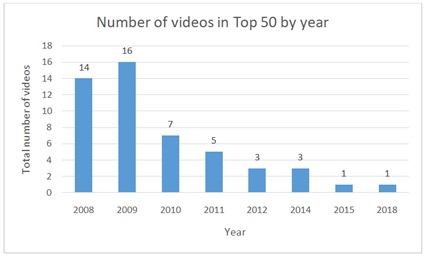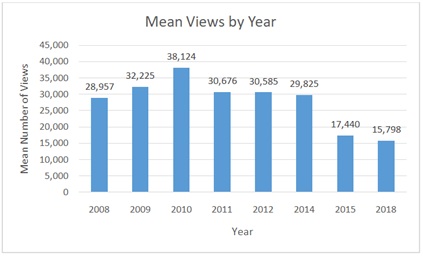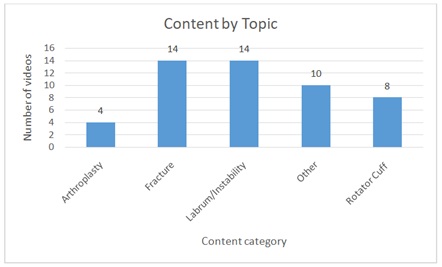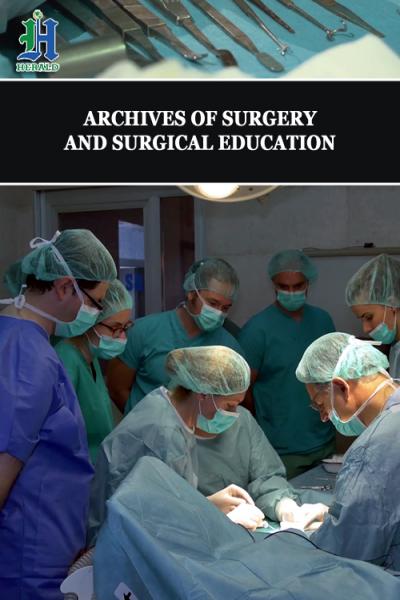
An Analysis of the 50 Most Viewed Shoulder-Related Video Postings
*Corresponding Author(s):
Nathan S LanhamDepartment Of Orthopaedic Surgery, Columbia University Irvine Medical Center, New York, United States
Tel:+1 5408409369,
Email:nathanscottlanham@gmail.com
Abstract
While traditional resources have included didactic lectures, clinical settings, operating room experience, as well as texts and journals, recent resources such as electronic and web-based platforms have become more available. The purpose of this study was to characterize the 50 most viewed shoulder-related video postings. We searched VuMedi for content under the content heading “Shoulder” and the top 50 most viewed shoulder-related videos were then recorded. Each video was reviewed and the following information was collected: authors, year of publication, geographic origin, the number of thumbs up, as well as the number of comments. In addition, videos were classified as technique videos or didactic videos. The total number of views of the top 50 videos ranged from 129,583 to 15,127.Sumant Krishnan had the most videos (5) on the top 50 list. The publication years of the top 50 videos ranged from 2008 to 2018, with 2009 accounting for the most videos. The number of videos by country of origin was led by the United States (n=38), followed by France (n=5), Austria (n=2), Switzerland (n=2), and Australia (n=1). The number of video views strongly correlated with the number of thumbs up (R=0.91, p < 0.01) and the number of comments (R2=0.80, p < 0.01). Videos that were published around 2009, involved either fracture or labrum/instability, and focused on surgical technique were the most favorable and frequently viewed. The present study provides a foundation from which the characterization of surgical sub-specialty videos as well as development of a validated metric to objectively assess video content and quality may begin.
Keywords
Shoulder surgery; Video; VuMedi
Introduction
Orthopaedic education has evolved remarkably over the last decade. While traditional resources have included didactic lectures, clinical settings, operating room experience, as well as texts and journals; more recent resources such as electronic and web-based platforms have become more available [1]. Over time, these electronic and web-based resources have become important sources used to gain knowledge and successfully navigate examinations for orthopaedic surgeons in-training [2]. Furthermore, some authors have found watching instructional videos prior to participating in a surgical procedure may shorten a trainee’s learning curve, leading to improved patient safety [3]. In a recent study performed by Rogers et al. [4], in which they determined the primary resources chosen by orthopaedic residents using an anonymous survey, the authors found resident physicians favored the use of multiple platforms, however, VuMedi was the most frequently used video based educational resource [4].
Deemed as “YouTube for surgeons”, VuMedi is a free resource for physicians, residents, and fellows and has a large international community of over 100,000 physicians [5]. It offers over 5,000 didactic and technical videos, with many from the over 35 hospital and clinics that are partnered with VuMedi [5]. Despite its popularity and use by many prominent shoulder surgeons, no authors have published on VuMedi content with respect to shoulder-related postings. Therefore, the purpose of this study was to characterize the 50 most viewed shoulder-related video postings.
Methods
In August 2020 we search VuMedi for content under the content heading “Shoulder”. The top 50 most viewed shoulder-related videos were recorded. Each video was reviewed and the following information was collected: authors, year of publication, geographic origin, the number of thumbs up, as well as the number of comments. In addition, videos were classified as technique videos or didactic videos. We defined technique videos as videos which demonstrate or describe surgical procedures and their nuances. We classified didactic videos as videos which focused on specific pathology or anatomy of the shoulder. Videos which had both technique and didactic elements were classified as such based on what element comprised the majority of the video. For example, a video totaling 12 minutes which possessed 5 minutes of technique content and 7 minutes of didactic content would be classified as a didactic video. Two authors (N.L. and N.D.) reviewed each video independently and determined video classification based on the aforementioned definitions. Any discrepancy between authors was resolved by consensus.
Author’s H-indices were obtained and recorded using Scopus through Columbia University Libraries. Finally, all videos were categorized by topic into one of the following groups: rotator cuff, arthroplasty, labrum/instability, fracture, and other.
Comparisons of means between groups were performed by use of the independent samples t test. Pearson r was used to test correlations between variables when both variables were continuous. All statistics were performed with Excel statistical software (Microsoft, Redmon, WA, USA).
Results
The total number of views of the top 50 videos ranged from 129,583 to 15,127 (Table 1). The publication years of the top 50 videos ranged from 2008 to 2018, with 2009 accounting for the most videos (Figure 1). The majority of the videos were published from 2008 to 2010 and only two videos were published after 2014. The mean number of views for each video, per year, from 2008 to 2018 ranged from 15,798 to 38,124 (Figure 2). All videos in the top 50 were published in English.
|
Rank |
Author/Video/Year of Publication |
Number of Views (View Frequency*) |
|
1 |
Gilles Walch/Latarjet-Patte Procedure/2009 |
129,583 (11,780) |
|
2 |
Mark Mighell/ORIF of Proximal Humerus Fracture using Locked Plating/2010 |
90,116 (9,012)
|
|
3 |
Gilles Walch/Live Reverse Total Shoulder Arthroplasty using a Deltopectoral Apporach/2009 |
69,317 (6,302)
|
|
4 |
Michael Gardner/Proximal Humerus ORIF: Exposure and Reduction Techniques/2011 |
55,226 (6,136)
|
|
5 |
David Altchek/Arthroscopic Bankart Repair/2008 |
55,180 (4,598) |
|
6 |
Georg Lajtai/Anatomical Shoulder Update 1 - Anatomy Demonstration/2009 |
53,067 (4,824)
|
|
7 |
Freddie Fu/Innovation in Sports Medicine - Is the Latest Always the Greatest?/2012 |
49,694 (6,212)
|
|
8 |
Christian Gerber/Anatomy and Treatment of the Rotator Cuff/2014 |
44,785 (7,464) |
|
9 |
Sumant Krishnan/Arthroscopic Rotator Cuff Repair using the Triangle Technique/2008 |
42,215 (3,518) |
|
10 |
Michael Gardner/ORIF of the Proximal Humerus Through an Anterolateral Acromial Approach/2010 |
40,814 (4,081) |
|
11 |
Brian Cole/Arthroscopic Bankart& SLAP Reapir/2008 |
39,119 (3,260) |
|
12 |
Sumant Krishnan/AC Joint Reconstruction with Hamstring Autograft/2010 |
38,954 (3,895) |
|
13 |
Sumant Krishnan/Biceps Tenodesis – Landmarks and Diagnostic Arthrscopy/2008 |
38,804 (3,234) |
|
14 |
Kenneth Egol/ORIF of Proximal Humerus Fracture/2011 |
33,064 (3,674) |
|
15 |
Gary Gartsman/Standard Arthroscopic Rotator Cuff Repair/2008 |
32,300 (2,692) |
|
16 |
Peter Millett/Plate Fixation of Midshaft Clavicle Fractures/2010 |
31,611 (3,161) |
|
17 |
Fredrick Matsen/Total Shoulder Replacement/2008 |
30,839 (2,570) |
|
18 |
JP Warner/Open Latarjet for Shoulder Instability/2009 |
30,367 (2,761) |
|
19 |
William Levine/Arthroscopic Repair of Massive Rotator Cuff Tear/2011 |
27,706 (3,078) |
|
20 |
JP Warner/Examination of the Shoulder for Rotator Cuff Disease/2010 |
26,878 (2,688) |
|
21 |
Eugene Wolf/Arthroscopic Bankart&Remplissage Procedure/2009 |
26,252 (2,387) |
|
22 |
Garry Gartsman/Biceps Tenodesis – Sutureless Technique/2009 |
26,026 (2,366) |
|
23 |
Richard Hawkins/Reverse Total Shoulder Arthroplasty: Steps to get it right/2012 |
25,719 (3,215) |
|
24 |
Joseph Abboud/ProximaHumerus Fracture Fixation Using Precontoured Locking Plate/2008 |
25,610 (2,134) |
|
25 |
Thomas Edwards/Latarjet Reconstruction for Anterior-Inferior Glenoid Bone Loss/2008 |
25,558 (2,129) |
|
26 |
Petter Millett/Suprascapular Nerve Entrapment – Arthroscopic Release/2008 |
23,740 (1,978) |
|
27 |
Joaquin Sanchez-Sotelo/Open Reduction and Locking Plate Fixation for Proximal Humerus Fractures/2014 |
23,709 (3,952) |
|
28 |
Neil Maki/Arthroscopic Shoulder Portals: Anatomic & Clinical Considerations/2009 |
22,698 (2,063) |
|
29 |
JP Warner/Hemiarthroplasty for Comminuted Fracture of the Proximal Humerus/2008 |
22,370 (1,864) |
|
30 |
Boileau Pascal/Reverse Shoulder Arthroplasty for the Treatment of Proximal Humerus Fractures in the Elderly Patient/2014 |
20,981 (3,497) |
|
31 |
Sumant Krishnan/Reverse Shoulder Arthroplasty for Acute Proximal Humerus Fracture/2009 |
20,915 (1,901) |
|
32 |
Russell Warren/Arthroscopic Rotator Cuff Repair/2008 |
20,313 (1,693) |
|
33 |
Stephen Snyder/Diagnostic Arthroscopy of the Shoulder: SCOI 15 Point Exam/2011 |
20,092 (2,232) |
|
34 |
Joaquin Sanchez-Sotelo/Humeral Shaft Fractures: Should I Nail It or Plate It?/2010 |
19,307 (1,931) |
|
35 |
Eduardo Carrea/Understanding the Humeral Neck Fractures/2010 |
19,186 (1,919) |
|
36 |
Gilles Walch/Latarjet – History, Indications, Results, & Technical Tips/2009 |
19,030 (1,730) |
|
37 |
Riley Williams/Arthroscopic SLAP Lesion Repair/2008 |
18,494 (1,541) |
|
38 |
Laurent Lafosse/Arthroscopic Biceps Tenodesis using Suture Anchor/2009 |
18,460 (1,678) |
|
39 |
Sumant Krishnan/Subpectoral Open Biceps Tenodesis using Interference Screw/2009 |
18,268 (1,661) |
|
40 |
Gregory Bain/Understanding Anatomy to Avoid Complications in Clavicle Fractures/2015 |
17,440 (3,488) |
|
41 |
Christian Gerber/Latissimus Dorsi Transfer in the Lateral Decubitus Position/2009 |
17,351 (1,577) |
|
42 |
Peter Millett/Pectoralis Major Tendon Ruptures/2011 |
17,293 (1,921) |
|
43 |
Evan Flatow/Arthroscopic Subscapularis Repair/2009 |
16,510 (1,501) |
|
44 |
Jeffrey Abrams/When is a SLAP better treated by biceps tenotomy or tenodesis/2009 |
16,373 (1,488) |
|
45 |
Roger Sohn/Scapular ORIF using Modified Judet Approach/2012 |
16,341 (2,043) |
|
46 |
Scott Sigman/Simplified Superior Capsule Reconstruction (SCR) Technique for Irrepairable Rotator Cuff Tears/2018 |
15,798 (7,899) |
|
47 |
Georg Lajtai/Anatomical Shoulder Update 2: Review of Anatomy & Athletes/2009 |
15,759 (1,433) |
|
48 |
Joseph Burns/Arthroscopic Repair of Bony Bankart Fracture/2008 |
15,731 (1,311) |
|
49 |
Augustus Mazzocca/AC Joint – When Should I Really Fix Them and How?/2009 |
15,626 (1,421) |
|
50 |
JP Warner/Total Shoulder Replacement using an Anatomical Shoulder System/2008 |
15,127 (1,261) |
|
|
*view frequency = Total number of views/Years since publication |
|
Table 1: Top 50 most viewed shoulder specific videos.
 Figure 1: Number of videos in top 50 by year of publication.
Figure 1: Number of videos in top 50 by year of publication.

Figure 2: Mean number of views by year of publication in top 50.
Videos originated from 5 countries. The number of videos by country of origin was led by the United States (n=38), followed by France (n=5), Austria (n=2), Switzerland (n=2), and Australia (n=1). Sumant Krishnan had the most videos (5) on the top 50 list. JP Warner had the second most videos (4) followed by Gilles Walch and Peter Millett each with 3 videos. Several authors (Christian Gerber, Gary Gartsman, Georg Lajtai, Joaquin Sanchez-Sotelo, Michael Gardner) had 2 videos in the top 50.
The majority of the videos (n=34) were technique oriented, while the remaining videos (n=16) were classified as didactic presentations. The mean number of views for the technique videos (n=32,984) was greater than that for the didactic videos (n=27,141) (p=0.79). Videos classified as “Fracture” or “Labrum/instability” accounted for over half (28) of the top 50 videos (Figure 3) and had a greater number of views (n=913,935) than videos classified as “Arthroplasty”, “Rotator cuff”, and “Other” (n=641,781), (p=0.54). The number of video views strongly correlated with the number of thumbs up (R=0.91, p < 0.01) and the number of comments (R2=0.80, p < 0.01).
 Figure 3: Classification of videos in top 50 by topic.
Figure 3: Classification of videos in top 50 by topic.
When the top 50 videos were analyzed by view frequency (Total number of views/Years since publication), Giles Walch’s Latarjet-Patte Procedure and Mark Mighell’s ORIF of Proximal Humerus Fracture using Locked Plating remained the top two videos (11,780 and 9,012 views/year). The most recently published video (Scott Sigman 2018) had the third highest view frequency (7,899 views/year).
The mean view frequency (views/year) was 3,295 for technique videos and 3,132 for didactic videos. Mean author H-index for all videos were 43.4. The mean author H-index for technique videos was 43.3 and 43.5 for didactic videos.
Discussion
There are likely several factors which relate to how often a VuMedi post is viewed as well its favorability. Some of these include but are not limited to year of publication, topic, author(s), and video type. This was the first analysis of video postings within a specific subspeciality area-namely, shoulder surgery. This study provides insight into the content and nature of some of the most widely viewed shoulder related videos on VuMedi.
Our results suggest videos that were published around 2009, involved either fracture or labrum/instability, and focused on surgical technique were the most favorable and frequently viewed. It is not surprising that the majority of these videos were published in the prior decade, because time provides an advantage in terms ofmore of an opportunity to gain popularity andachieve positive feedback. Topics involving fracture or labrum/instability comprised the majority of video postings in the top 50. Other topics such as arthroplasty and rotator cuff, which represent a larger proportion of shoulder specific cases in most practice settings, where not as popular or as frequently viewed. The exception to this observation was Scott Sigman’s Simplified Superior Capsule Reconstruction (SCR) Technique which was published in 2018. This video post accounted for the third highest view frequency behind Giles Walch’s Latarjet-Patte Procedure and Mark Mighell’s ORIF of Proximal Humerus Fracture using Locked Plating. A possible explanation for this finding is that SCR is a novel surgical technique which has garnered significant attention both from industry and the literature in recent years [6,7].
Furthermore, we found all of the authors of the videos in the present study possessed H-indices which were, on average, greater than 43. This H-index valuerepresents a more than 90th percentile score for the H-index [8] and suggests authors were equally successful in published literature with regard to influence and citation frequency. The H-index also provides a surrogate for what can be considered a quality metric for each video as it is likely that authors in the 90th percentile for the H-index would also produce video content with similar quality based on their published literature.
While no prior authors have attempted to characterize specialty specific videos, some authors have attempted to evaluate multimedia use and characterize surgical video resources available online. Serino et al. [5], performed a review to describe the type, volume, quality and value of surgical video resources available online with an emphasis on orthopaedic surgery. Of the resources studied, none demonstrated high scores for value, quality, and volume. VuMedi had the second highest combined score behind Medline Plus. However, details of the content differences between the two resources were not provided by the authors. The authors concluded that the best resource is highly dependent upon each user’s individual preferences [5].
An analysis of more 150 accredited orthopaedic residency programs found electronic platforms were an overwhelmingly common resource utilized as supplement to both general knowledge and case preparation [4]. The authors concluded that current residents-regardless of sex, location, and year in training-use electronic resources as the mainstay of their fund of knowledge and for case preparation. Concern over content quality and accuracy was also emphasized. Rapp et al. [9], found a discrepancy in the use of higher-quality videos when comparing surgical residents and faculty surgeons. They found that surgical residents were more likely to access videos on websites available to the public, such as YouTube, whereas faculty surgeons accessed more reliable sources such as society web pages and commercial videos [9].
While the present study provides insight into a frequently used electronic platform for shoulder surgical education, there are limitations. These include lack of a validated metric to objectively assess video content and quality. Another limitation relates to our evaluation of a small sub-specialty group of videos, which may not represent other populations that have been evaluated more generally in other studies.
Surgical education is changing with evolving technology and instant access to unlimited resources, as well as a large volume of yearly publications in the field [10]. More than 600,000 articles are published in biomedical literature every year, providing an insurmountable mountain of ever changing medical literature [10]. Resident physicians are clearly users of technology and have been raised in a generation in which healthcare is available on Internet platforms and resources are electronically at their fingertips [11]. Given their ubiquitous adoption and use, it’s important to not only identify, but also to characterize electronic and web-based resources such as VuMedi [12]. Future studies should further explore similar platforms in other sub-specialty areas and apply objective criteria for evaluating videos in terms of content and quality.
Conclusion
The present study characterized the 50 most viewed shoulder-related video postings on VuMedi. We found videos that were published around 2009, involved either fracture or labrum/instability, and focused on surgical technique were the most favorable and frequently viewed. The exception to this observation was Scott Sigman’s Simplified Superior Capsule Reconstruction (SCR) Technique which was published in 2018. The present study provides a foundation from which the characterization of surgical sub-specialty videos as well as development of a validated metric to objectively assess video content and quality may begin.
References
- Wolf BR, Britton CL (2013) How orthopaedic residents perceive educational resources. Iowa Orthop J 33: 185-190.
- Nagengast ES, Ramos MS, Sarma H, Deshpande G, Hatcher K, et al. (2014) Surgical education through video broadcasting. J CraniofacSurg 25: 1619-1621.
- Crawshaw BP, Steele SE, Lee EC, Delaney CP, Mustain WC, et al. (2016) Failing to prepare is preparing to fail: A single-blinded, randomized controlled trial to determine the impact of preoperative instructional video on the ability of residents to perform laparoscopic right colectomy. Dis Colon Rectum 59: 28-34.
- Rogers MJ, Zeidan M, Flinders ZS, Presson AP, Burks R (2019) Educational resources utilization by current orthopaedic surgical residents: A nation-wide survey. JAAOS Glob Res Rev 3: 041.
- Serino J, von Keudell A (2016) The state of surgical video: Comparison of currently available resources. The Orthpaedic Journal at Harvard Medical School 17: 56-62.
- Dimock RA, Malik S, Consigliere P, Imam MA, Narvani AA (2019) Superior capsule reconstruction: What do we know? Arch Bone Jt Surg 7: 3-11.
- Galvin JW, Kenney R, Curry EJ, Parada SA, Eichinger JK, et al. (2019) Superior capsular reconstruction for massive rotator cuff tears: A critical analysis review. JBJS Rev 7: 1.
- El Eman K, Arbuckle L, Jonker E, Anderson K (2012) Two h-index benchmarks for evaluating the publication performance of medical informatics researchers. J Med Internet Res 14: 144.
- Rapp AK, Healy MG, Charlton ME, Keith IN, Rosenbaum ME, et al. (2016) YouTube is the most frequently used educational video source for surgical preparation. J Surg Educ 73: 1072-1076.
- Davidson AR, Loftis CM, Throckmorton TW, Kelly DM (2016) Accessibility and availability of online information for orthopaedic surgery residency programs. Iowa Orthop J 36: 31-36.
- Parekh SG, Nazarian DG, Lim CK (2004) Adoption of information technology by resident physicians. ClinOrthopRelat Res 421:107-111.
- Tarpada SP, Morris MT, Burton DA (2016) E-learning in orthopaedic surgery training: A systematic review. J Orthop 13: 425-430.
Citation: Ahmed R, Lanham NS, Dantzker N, Jobin CM, Levine WN (2021) An Analysis of the 50 Most Viewed Shoulder-Related Video Postings. Archiv Surg S Educ 3: 0263.
Copyright: © 2021 Rifat Ahmed, et al. This is an open-access article distributed under the terms of the Creative Commons Attribution License, which permits unrestricted use, distribution, and reproduction in any medium, provided the original author and source are credited.

